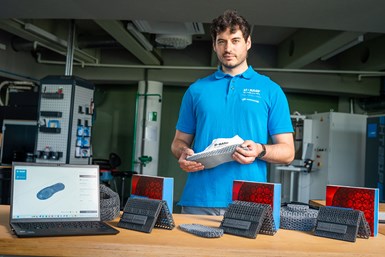Ultrasim 3D Lattice Engine Simplifies Lattice Selection, Generation
The solution is powered by Hyperganic and offers a wide array of lattice patterns, each of which has been tested and validated for different application groups.
BASF Forward AM’s latest software solution is the Ultrasim 3D Lattice Engine, which gives users easy access to a program designed to explore different lattice geometries and implement them into product design cycles. Powered by Hyperganic, this solution offers a wide array of lattice patterns, each of which has been tested and validated for different application groups.
Whether designing a new footwear product, seat or protective sporting equipment, there is a lattice geometry that meets the unique requirements of each application. Users can access an extensive lattice library in the form of physical test pads, which is the first step toward experiencing the wide range of properties lattices can achieve. From there, the user can then choose the lattice that best suits their part requirements and input that information into the software tool to create a digital overview of the mechanical properties.
After inputting the desired application area, the software finds lattice designs validated for similar use cases, then uses comprehensive modeling to automatically generate lattice parts that fit the user’s design parameters. Powered by Hyperganic’s assembly-level voxel engine, the lattice parts are generated and modulated within seconds.
The Ultrasim 3D Lattice Engine puts Forward AM‘s years of 3D lattice research and validation within reach, enabling users to facilitate the creation of cutting-edge products that require high-performance lattices. This software is bringing design and production to engineers and other users who are untrained in latticing, making it easy to enerate custom lattice in minutes. It also simplifies the development process by utilizing pre-engineered lattices adapted to the material and application.
- Watch this episode of The Cool Parts Show to hear about EOS’ Aerospike Engine and the geometric form which was designed using an algorithmic modeling platform from Hyperganic.
- Read this article on ‘What Does Additive Manufacturing Readiness Look Like?’ which mentions the BASF partnership with GKN Additive and Additive Manufacturing Technologies to produce 60,000 3D printed seals needed for the 2022 GM Chevy Tahoe.
- Check out this story on Hilos’ custom heels which feature a 3D printed shoe platform made from BASF's thermoplastic polyurethane (TPU), a flexible polymer with lattice structure printed into the footbed to provide all the cushion the shoe needs.
Related Content
-
3D Printed "Evolved Structures" for NASA Exoplanet Balloon Mission: The Cool Parts Show #61
Generative design creates stiff, lightweight brackets for EXCITE mission monitoring planets orbiting other stars. The Cool Parts Show visits Goddard Space Flight Center.
-
ActivArmor Casts and Splints Are Shifting to Point-of-Care 3D Printing
ActivArmor offers individualized, 3D printed casts and splints for various diagnoses. The company is in the process of shifting to point-of-care printing and aims to promote positive healing outcomes and improved hygienics with customized support devices.
-
Decentralized Manufacturing Network Aims to Make 3D Printers a Shared Global Resource
The 3DOS additive manufacturing network will let OEMs and creators take advantage of open 3D printer capacity anywhere in the world.












